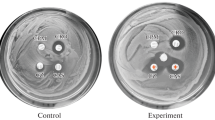Summary
The in vitro activity of gentamicin, tobramycin, sisomicin, netilmicin, amikacin, kanamycin and streptomycin was tested simultaneously by the agar dilution method against 584 clinical isolates of gram-negative bacilli that were resistant to gentamicin and/or tobramycin. About half of the gentamicin-resistantPseudomonas were susceptible to tobramycin but cross-resistance was virtually complete between gentamicin and tobramycin forEnterobacteriaceae. Sisomicin was much more active than gentamicin againstKlebsiella, Escherichia andCitrobacter species. Only 18.9%, 27.4% and 27.9% ofKlebsiella, Enterobacter andSerratia respectively were resistant to netilmicin. Amikacin was the most effective aminoglycoside with an overall resistance of 15.6%. Kanamycin was effective against 40% ofProteus andProvidencia species. Surprisingly, more than half ofKlebsiella andEnterobacter species and 85.3% ofSerratia species were susceptible to streptomycin.
Zusammenfassung
Die Wirksamkeit von Gentamycin, Tobramycin, Sisomycin, Netilmycin, Amikacin, Kanamycin und Streptomycin in vitro wurde mit der Agarverdünnungsmethode gleichzeitig an 584 klinischen Isolaten gramnegativer Bakterien geprüft, die gegenüber Gentamycin und/oder Tobramycin resistent waren. Etwa die Hälfte der gentamycinresistentenPseudomonas-Arten waren gegen Tobramycin empfindlich, doch bestand bei denEnterobacteriaceae praktisch vollständige Kreuzresistenz zwischen Gentamycin und Tobramycin. Sisomycin war gegenKlebsiella, Escherichia undCitrobacter weitaus wirksamer als Gentamycin. Nur jeweils 18,9%, 27,4% und 27,9% der GattungenKlebsiella, Enterobacter undSerratio waren gegen Netilmycin empfindlich. Amikacin war mit einer Gesamtresistenz von 15,6% das wirksamste Aminoglykosid. Kanamycin war gegen 40% der GattungenProteus undProvidencia wirksam. Erstaunlicherweise erwies sich mehr als die Hälfte der GattungenKlebsiella undEnterobacter sowie 85,3% der GattungSerratia gegenüber Streptomycin empfindlich.
Similar content being viewed by others
Literature
Knothe, H., Krcmery, V., Sietzen, W., Borst, J. Transfer of gentamicin resistance fromPseudomonas aeruginosa strains highly resistant to gentamicin and carbenicillin. Chemotherapy 18 (1973) 229–234.
Bryan, L. E., Shahrabadi, M. S., Van Den Elzen, M. H. Gentamicin-resistance inPseudomonas aeruginosa: R-factor-mediated resistance. Antimicrob. Ag. Chemother. 6 (1974) 191–199.
Baird, I. M., Slepack, J. M., Kauffman, C. A., Phair, J. P. Nosocomial infection with gentamicin-carbenicillin-resistantPseudomonas aeruginosa. Antimicrob. Ag. Chemother. 10 (1976) 626–629.
Chadwick, P. Resistance ofPseudomonas aeruginosa to gentamicin. Canad. Med. Assoc. J. 109 (1973) 585–587.
Draser, F. A., Farrell, W., Maskell, J., Williams, J. D. Tobramycin, amikacin, sisomicin, and gentamicin resistant gram- negative rods. Br. Med. J. 2 (1976) 1284–1287.
Gaman, W., Cates, C., Snelling, C. F. T., Lank, B., Ronald, A. R. Emergence of gentamicin- and carbenicillin-resistantPseudomonas aeruginosa in a hospital environment. Antimicrob. Ag. Chemother. 9 (1976) 474–480.
Meyer, R. D., Lewis, R. P., Halter, J., White, M. Gentamicin-resistantPseudomonas aeruginosa andSerratia marcescens in a general hospital. Lancet 1 (1976) 580–583.
Rennie, R. P., Duncan, I. B. R. Emergence of gentamicin-resistantKlebsiella in a general hospital. Antimicrob. Ag. Chemother. 11 (1977) 179–184.
Devaud, M., Kayser, F. H., Huber, U. Resistance of bacteria to the newer aminoglycoside antibiotics: an epidemiological and enzymatic study. J. Antibiot. 30 (1977) 655–664.
Bauer, A. W., Kirby, W. M. M., Sherris, J. C., Turck, M. Antibiotic susceptibility testing by a standardized single disk method. Am. J. Clin. Pathol. 45 (1966) 493–496.
Ericsson, H. M., Sherris, J. C.: Antibiotic sensitivity testing: report of an international collaborative study. Acta Pathol. Microbiol. Scand. (B) Suppl. (1971) 1–90.
Steers, E., Foltz, E. L., Graves, B. S. An inocula replicating apparatus for routine testing of bacterial susceptibility to antibiotics. Antimicrob. Chemother. 9 (1959) 307–311.
Watanakunakorn, C., Bannister, T. In vitro activity of tobramycin and gentamicin againstEnterobacteriaceae and gentamicin-resistant, carbenicillin-resistantPseudomonas aeruginosa. Curr. Therap. Res. 17 (1975) 488–496.
Meyer, R. D., Kraus, L. L., Pasiecznik, K. A. In vitro susceptibility of gentamicin-resistantEnterobacteriaceae andPseudomonas aeruginosa to netilmicin and selected aminoglycoside antibiotics. Antimicrob. Ag. Chemother. 10 (1976) 677–681.
Price, K. E., DeFuria, M. D., Pursiano, T. A. Amikacin, an aminoglycoside with marked activity against antibiotic-resistant clinical isolates. J. Infect. 134 (1976) S249-S261.
Craven, P. C., Jorgensen, J. H., Kaspar, R. L., Drutz, D. J. Amikacin therapy of patients with multiply antibiotic-resistantSerratia marcescens infections. Am. J. Med. 62 (1977) 66–74.
Meyer, R. D. Patterns and mechanisms of emergence of resistance to amikacin. J. Infect. Dis. 136 (1977) 449–452.
Overturf, G. D., Zawacki, B. E., Wilkins, J. Emergence of resistance to amikacin during treatment of burn wounds: the role of antimicrobial susceptibility testing. Surgery 79 (1976) 224–228.
Noriega, E. R., Leibowitz, R. E., Richmond, A. S., Rubinstein, E., Schaefler, S., Simberkoff, M. S., Rahal, J. J. Nosocomial infection caused by gentamicin-resistant, streptomycin-sensitiveKlebsiella. J. Infect. Dis. 131 (1975) S45-S50.
Author information
Authors and Affiliations
Rights and permissions
About this article
Cite this article
Watanakunakorn, C., Kauffman, C.A. In vitro susceptibility of gentamicin and/or tobramycin resistant gram-negative bacilli to seven aminoglycosides. Infection 6, 111–115 (1978). https://doi.org/10.1007/BF01642258
Received:
Issue Date:
DOI: https://doi.org/10.1007/BF01642258



